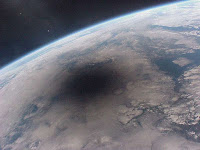Solar eclipses are natural phenomena that occur when the Moon passes between the Earth and the Sun, obscuring the latter.
This event is so unnatural that it astonishes and amazes not just humans, but many others living creatures. Studies have shown that animals react strangely to solar eclipses. Their behaviour is driven by the absence of sunlight where there should be and, in fact, depending on the animal, they usually prepare to sleep.
[This is a post which is part of the series: 5 unmissable celestial events]
Physical background:
The word Eclipse refers to an event in which a body is occulted by another body. Eclipses can happen with any astronomical object, but the most relevant ones, visible to naked eyes, are the lunar and solar eclipses. In lunar eclipses, the Moon is eclipsed by Earth's shadow and in solar eclipses the Sun is eclipsed by the Moon's shadow.
An eclipse happens when 3 celestial bodies are aligned, and perfectly aligned (also their centres of mass must be aligned) for total eclipses.
 |
| A total solar eclipse. The light passing throught is the corona of the Sun |
- Partial Solar Eclipse: the most frequent (yearly or more) and the most common, the Sun is not totally obscured by the Moon, because not in perfect alignment with it.
- Annular Solar Eclipse: similar to the partial one, but the Sun is in line with Moon and Earth. It isn't totally obscured because the shadow created by the moon is smaller, then a "ring of sun" around the moon can be still seen.
- Total Solar Eclipse: a very rare event in witch the Sun is totally obscured by the Moon.
So called Hybrid solar eclipses can also happen, where both an annular and a total solar eclipse occur on the same alignment but on different timings.
We see different kinds of eclipses all around the world, anyway, and not that frequently! What's missing in this model, then?
 |
| Sketch showing Earth, Moon and Sun in conjunction. Umbra and Penumbra regions are annotated. |
Partial solar eclipses are seen in the penumbra region and total solar eclipses or annular eclipses in the umbra region. The first (total) occurs when the apparent sizes of the Moon and the Sun are about the same, while the second (annular) when the apparent sizes of the Moon is slightly smaller than the one of the Sun.
 |
| Shadow of the Moon on Earth |
Result:
Eclipses at sunsets are my favourite and the most beautiful. The sky darkens, some stars appears (especially Mercury, during total eclipses) and an unreal atmosphere falls on the Earth for some minutes, with the sun still in the sky. A very mystic atmosphere.
Locations:
Everywhere on Earth, you just need some luck (a lot, actually since they occur in the same place once every 370 years, on average! 18 months, everywhere).
The second link below list the upcoming solar and lunar eclipses, with their location and length. Often trips are organized to go and see them. Don't be patient and think of waiting for one in your country, if you have the occasion to catch a trip. For your information, there is only one total eclipse in central Europe for the present century, and it's in 2081!
Interesting Links:
All the types of solar eclipses explained using animations
Past and Future eclipses dates including locations
Ancient Greeks' ingenious machine to predict eclipses
Abstract about the effect of solar eclipses on animals


No comments:
Post a Comment